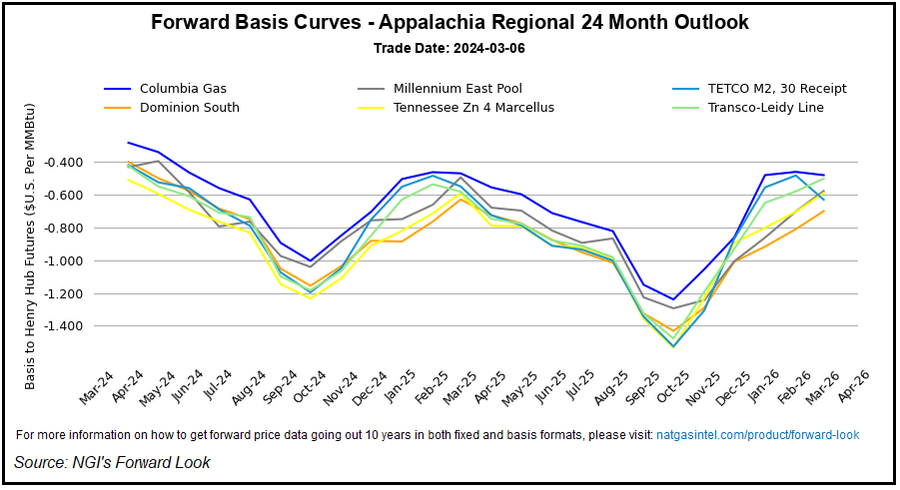Regional natural gas forwards generally pushed higher at the front of the curve during the Feb. 29-March 6 trading period as ebbing production strengthened the price outlook for a market dealing with excess supply exiting winter, NGI’s Forward Look data show.

Fixed prices for April delivery at benchmark Henry Hub added 4.0 cents for the period to finish at $1.937, and aside from some selling in the Western Lower 48, most locations finished in positive territory week/week at the front of the curve.
EQT And Appy Basis
The work week kicked off with an announcement from the largest U.S. natural gas producer, EQT Corp., that it is curtailing 1.0 Bcf/d of production through March.
The move by EQT helped explain a notable drop in Northeast volumes in recent production estimates, and it brought incremental bullishness for spring and summer basis in Appalachia, according to Forward Look data.
EQT’s curtailments appear to have started around Feb. 24 and have been focused in the Southwest Pennsylvania portion of the Marcellus Shale, East Daley Analytics analyst Jack Weixel said during a recent discussion on energy chat platform Enelyst.
“EQT employed a similar strategy in 2020, shutting in about 1.4 Bcf/d when Appalachian prices fell below $1.50,” Weixel said. “The producer brought back supply three months later, only to reduce volumes once again in September 2023. EQT restarted full production heading into the winter after prices recovered above $1.50.”
A number of Appalachian hubs, including Eastern Gas South, Millennium East Pool and Texas Eastern M-2, 30 Receipt, saw negative basis differentials narrow for the upcoming injection season during the Feb. 29-March 6 trading period.
For example, Texas Eastern M-2, 30 Receipt June 2024 basis rallied 9.0 cents for the period, ending at minus-55.9 cents, Forward Look data show.
The trend is even more noticeable when going back to pre-EQT-curtailment trading.
Texas Eastern M-2, 30 Receipt has strengthened by double digits across the 2024 injection season since Feb. 22. October 2024 basis at the hub has rallied 14.6 cents since then, narrowing the discount to Henry to minus-$1.196.
Over the same span, May 2024 basis at the location has shaved off 14.0 cents to close to within 52.4 cents of the national benchmark, according to Forward Look.
Chesapeake’s ‘Novel Strategy’
Of course, EQT is only one among a slew of exploration and production (E&P) companies to recently signal natural gas production cuts in response to weak prices.
Chesapeake Energy Corp., another major U.S. natural gas producer, set the tone late last month when it announced activity reductions in the Marcellus and Haynesville shales while guiding for substantially lower output in 2024.
Oil and Gas Financial Analytics LLC director Tom Biracree, in a recent blog for RBN Energy LLC, described Chesapeake’s plans as a “novel strategy that will slash production by 25% but leave the E&P ready to quickly ramp up its output as soon as demand and prices warrant.”
Cutting back on investment and output in the face of recent historically weak commodity prices is not necessarily a simple decision for producers, according to Biracree.
“For smaller producers who need to make payroll, scaling back operations may be impractical,” Biracree said. “For larger producers, strategic capital allocation decisions are complicated by the anticipated dramatic gas demand growth in 2025 to 2028,” including from new LNG export capacity hitting the market.
Looking specifically at Chesapeake, the operator appears to be aiming to align supply with demand by prioritizing the buildout of a “substantial inventory” of “wells that have been drilled and completed up to the final step of turning them in line,” according to Biracree.
Along with plans for a modest increase in drilled but uncompleted wells, Chesapeake’s anticipated inventory of 80 wells ready to turn to sales by the fourth quarter should allow the operator to “quickly respond to price signals,” the analyst added.
Pacific Selling
Meanwhile, California hubs conspicuously deviated from the broader, modestly positive, movement of regional forwards trading around the Lower 48 during the Feb. 29-March 6 period.
Fixed prices came down sharply at the front of the curve at SoCal Citygate, with April, May and June each giving back 40-plus cents week/week, Forward Look data show.
SoCal Citygate fell to $2.643 for the period, off 47.7 cents but still at a hefty mark-up to Henry Hub.
Premium pricing at PG&E Citygate also fell week/week, with April fixed prices dropping 17.2 cents to $2.828.
In contrast to the year-earlier period, storage inventories in the Mountain and Pacific regions are exiting the 2023/24 heating season at an ample surplus to historical levels, according to U.S. Energy Information Administration (EIA) data.
A year ago, following price spikes during the 2022/23 winter, Mountain and Pacific region storage exited the season below historical norms, particularly the Pacific, EIA data show.
Fast forward to the week ended Mar. 1, and Mountain region storage sat at 169 Bcf, a 77.9% surplus to the five-year average and 79.8% above year-earlier levels. At 219 Bcf, the Pacific sat at a 43.1% surplus to the five-year and at a whopping 154.7% surplus versus a year ago, according to EIA.
For the week ended March 1, the Mountain and Pacific regions accounted for 74% of the total U.S. year/year inventory surplus “despite those regions containing only 19% of the nation’s storage capacity,” Wood Mackenzie analyst Eric McGuire observed in a recent note.







